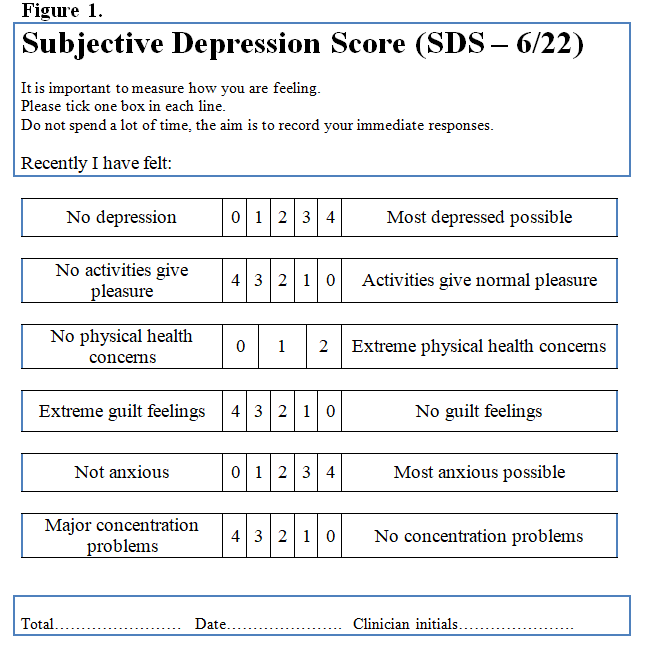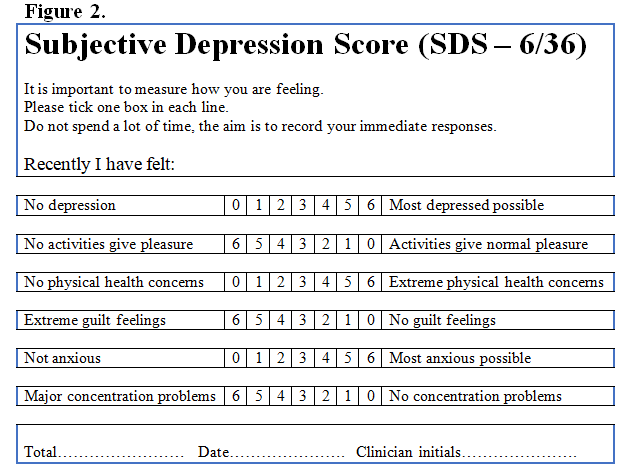A new six-item Subjective Depression Scale (SDS-6)
Saxby Pridmore 1, Ahmed Naguy 2, William Pridmore 3, Tamara May4,
1College of Medicine and Health, University of Tasmania, Australia; 2Kuwait Centre for Mental Health, Shuwaikh, Kuwait; 3Tasmanian Health Service, Tasmania, Australia; 4Department of Pediatrics, Monash University, Clayton, Victoria, Australia.
Correspondence: Prof. Saxby Pridmore Email: s.pridmore@utas.edu.au
Received: 5/11/2021; Revised: 22/11/21; Accepted: 25/11/2021
Key words: Depression rating scale; major depressive disorder; six-item Hamilton Depression Rating scale.
[citation: Pridmore, Saxby., Naguy, Ahmed., Pridmore, William., & May, Tamara. (2021). A new six-item Subjective Depression Scale (SDS-6). Dynamics of Human Health (DHH), 8(4): http://www.journalofhealth.co.nz/?page_id=2629]
Abstract
We describe a new 6-item subjective depression rating scale which may function as a companion to the objective six-item Hamilton Depression Rating Scale (HAMD-6), or other objective mood scales. We provide the scale and invite others to conduct a trial.
Introduction
Major depressive disorder (MDD) and other mood problems are quantified using objective and subjective means. Objective assessment refers to the questions clinicians ask and the responses they receive, and the observations they make regarding appearance and behavior. Subjective assessment refers to the inner/private thinking and emotional experiences of patients.
There are many well established assessment tools, all with their own strengths and weaknesses. A leading objective tool is the Hamilton Depression Rating Scale (HAMD) which was first published/described more than 60 years ago [1]. The first HAMD version was composed of 17 separate items (questions/observations). Subsequently, larger versions with more with more items were released. Then a very short version of only six items (HAMD-6) was released [2].
The HAMD-6 has the advantage of being quick and easy to administer [3]. In relation to the longer forms, it has comparable sensitivity [4] validity and reliability [5]. It is superior to the longer forms in scalability and change discrimination [6].
The HAMD-6 examines 1) depressed mood, 2) anhedonia (inability to experience pleasure), 3) physical health concerns, 4) guilt feelings, 5) anxiety, and 6) retardation. To examine the subjective experience of patients, our group developed a 6-item visual analogue scales (VAS6) matching the above dimensions [7]. As the “retardation” item is fundamentally an observation, in 6th place we substituted what we considered to be a related question, an exploration of the patient’s experience of concentration difficulties. We showed the VAS6 was a valid measure of core aspects of depression measured by the HAMD-6 [7]. The HAMD6 and the VAS6 made good companions.
While the VAS6 is simple, some individuals find the lack of structure makes responding difficult; they hesitate, uncertain about which direction increases the magnitude of their response. Also, scoring is not straightforward – a ruler must be mechanically applied to the page, and the reproduction process of the test sheet may cause the length of the reproduced line to vary by up to 1 cm, meaning mathematical manipulation is required to standardize the results.
A new Scale
We have developed a new scale, the six-item Subjective Depression Scale (SDS-6), which we expect/hope will be useful in the measurement of the subjective experience of people suffering MDD. Again, we have used the 6 items incorporated in the HAMD6 – research has confirmed the HAMD6 is unidimensional with strong homogeneity for evaluating MDD [5, 8]. We believe the SDS-6 could be a useful companion for the HAMD-6, but it may also be suitable for complimenting other objective instruments.
We have used the same anchor points as we used in the VAS6, but instead of a featureless straight line, we introduced ascending numbers. We have interdigitated the items – in the first, numbers ascend moving to the right, in the second they ascend moving to the left, in the third the numbers ascend moving to the right, and so on. Participants are asked to tick one box/number in each row.
Two versions of the SDS-6 are available – the have different numbers/options. One is specifically designed as a companion to the HAMD6. In the HAMD6 the numbers for the first, second, fourth, fifth and sixth, are 0-4. In the third item (physical health concerns) they are less, 0-2. We have used these numbers. This gives a maximum total of 22, thus we have labeled this version SDS-6/22. (Figure 1).

The other version could be used with the HAMD6, but it might well be used as a companion to other objective instruments. To avoid the two different sets of numbers used in the HAMD6, we have arranged the numbers in each item to be the same: 0-6. Accordingly, the maximum possible score is 36 and we have labeled this version SDS-6/36. Figure 2.

Concluding comment
We hope to trial these scales in the near future. However, should anyone be interested to try either of them now, we would be delighted. The email address of the Corresponding Author is listed above, and we would be interested in any feedback.
Funding: This research did not receive any specific grant from funding agencies in the public, commercial or not-for-profit sectors.
Conflict of Interest: The authors have no conflicts of interest.
References
[1] Hamilton M. (1960) A rating scale for depression. J Neurol Neurosurg Psychiatry 23(1): 56-62.
[2] Bech P, Allerup P, Gram L, et al. (1981) The Hamilton Depression Scale. Acta Psychiatr Scand 63: 290-299.
[3] Hooper C, Bakish D. (2000) An examination of the sensitivity of the six-item Hamilton Rating Scale for Depression in a sample of patients suffering from major depressive disorder. J Psychiatry Neurosci 25(2): 178-184.
[4] O’Sullivan R, Fava M, Agustin C, et al. (1997) Sensitivity of the six-item Hamilton Depression Rating Scale. Actsa Psychiatr Scand 95:379-384.
[5] Lee C-P, Liu C-Y, Hunh C-I. (2017) Psychometric evaluation of a 6-item Chinese version of the Hamilton Depression Rating Scale: Mokken scaling and item analysis. Asia Pac Psychiatry 9(3): e12287. Doi: 10.1111/appy.12287.
[6] Kyle P, Lemming O, Timmerby N, et al. (2016) The validity of the different versions of the Hamilton Depression scale in separating remission rates of placebo and antidepressants in clinical trials of major depression. J Clin Psychopharmacol 36(5): 453-456.
[7] May T, Pridmore S. (2020) A visual analogue scale companion for the six-item Hamilton Depression Rating Scale. Australian Psychologist 55(1): 3-9.
[8] da Silva A, Reche M, da Silva Lima, et al. (2019) Assessment of the psychometric properties of the 17- and 6-item Hamilton Depression Rating Scales in major depressive disorder, bipolar depression and bipolar depression with mixed features. J Psychiatr Res 108: 84-89. doi: 10.1016/j.jpsychires.2018.07.009.